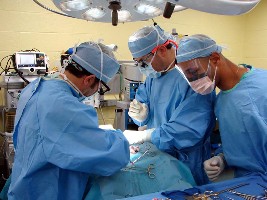A study of simulated surgical procedures found surgical sponges with embedded radio-frequency (RF) chips were detected when placed out of visual sight under the patients, many of whom were obese. The findings appear in the February issue of The American Journal of Surgery (paid subscription required).
Retained surgical items — those left in the patient’s body after surgery — are serious medical errors, which happen infrequently. A review of 191,000 procedures between 2003 and 2006 found 68 incidents of retained objects, half of which were near-misses where the missing objects were later found. Of the 34 cases where objects were left behind, 23 involved surgical sponges.
In this study, Victoria Steelman of the Veterans Affairs Medical Center in Iowa City, Iowa sequentially placed four surgical sponges with RF chips behind the supine torsos of 210 subjects. About half of the subjects (101) were morbidly obese. The potential for missing sponges increases among patients with larger body mass.
An RF detector found all four of the hidden sponges for each of the 210 subjects, including the obese subjects. Steelman reported no false-positive or false-negative readings.
* * *


 RSS - Posts
RSS - Posts
You must be logged in to post a comment.